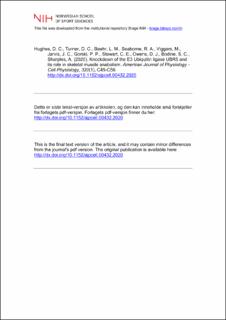| dc.contributor.author | Hughes, David C. | |
| dc.contributor.author | Turner, Daniel C. | |
| dc.contributor.author | Baehr, Leslie M. | |
| dc.contributor.author | Seaborne, Robert A. | |
| dc.contributor.author | Viggars, Mark | |
| dc.contributor.author | Jarvis, Jonathan C. | |
| dc.contributor.author | Gorski, Piotr Patryk | |
| dc.contributor.author | Stewart, Claire E. | |
| dc.contributor.author | Owens, Daniel J. | |
| dc.contributor.author | Bodine, Sue C. | |
| dc.contributor.author | Sharples, Adam | |
| dc.date.accessioned | 2022-02-15T09:29:23Z | |
| dc.date.available | 2022-02-15T09:29:23Z | |
| dc.date.created | 2020-10-14T12:22:39Z | |
| dc.date.issued | 2020 | |
| dc.identifier.citation | American Journal of Physiology - Cell Physiology. 2020, 320(1), C45-C56. | en_US |
| dc.identifier.issn | 0363-6143 | |
| dc.identifier.uri | https://hdl.handle.net/11250/2979004 | |
| dc.description | I Brage finner du siste tekst-versjon av artikkelen, og den kan inneholde ubetydelige forskjeller fra forlagets pdf-versjon. Forlagets pdf-versjon finner du på journals.physiology.org / In Brage you'll find the final text version of the article, and it may contain insignificant differences from the journal's pdf version. The definitive version is available at journals.physiology.org. | en_US |
| dc.description.abstract | UBR5 is an E3-ubiquitin-ligase positively associated with anabolism, hypertrophy and recovery from atrophy in skeletal muscle. The precise mechanisms underpinning UBR5's role in the regulation of skeletal muscle mass remains unknown. The present study aimed to elucidate these mechanisms by silencing the UBR5 gene in-vivo. To achieve this aim, we electroporated a UBR5-RNAi plasmid into mouse tibialis anterior muscle to investigate the impact of reduced UBR5 on mechano-transduction signalling MEK/ERK/p90RSK and Akt/GSK3β/p70S6K/4E-BP1/rpS6 pathways. Seven days post UBR5 RNAi electroporation, while reductions in overall muscle mass were not detected, mean CSA of GFP-positive fibers was reduced (-9.5%) and the number of large fibers was lower versus the control. Importantly, UBR5-RNAi significantly reduced total RNA, muscle protein synthesis, ERK1/2, Akt and GSK3β activity. Whilst p90RSK phosphorylation significantly increased, total p90RSK protein levels demonstrated a 45% reduction with UBR5-RNAi. Finally, these early events after 7 days of UBR5 knockdown culminated in significant reductions in muscle mass (-4.6%) and larger reductions in fiber CSA (-18.5%) after 30 days. This was associated with increased levels of the phosphatase PP2Ac, and inappropriate chronic elevation of p70S6K and rpS6 between 7 and 30 days, and corresponding reductions in eIF4e. This study demonstrates UBR5 plays an important role in anabolism/hypertrophy, whereby knockdown of UBR5 culminates in skeletal muscle atrophy. | en_US |
| dc.language.iso | eng | en_US |
| dc.subject | Akt | en_US |
| dc.subject | ERK | en_US |
| dc.subject | RNai | en_US |
| dc.subject | skeletal muscle | en_US |
| dc.subject | PP2Ac | en_US |
| dc.subject | UBR5 | en_US |
| dc.title | Knockdown of the E3 Ubiquitin ligase UBR5 and its role in skeletal muscle anabolism | en_US |
| dc.type | Peer reviewed | en_US |
| dc.type | Journal article | en_US |
| dc.description.version | acceptedVersion | en_US |
| dc.source.pagenumber | C45-C56 | en_US |
| dc.source.volume | 320 | en_US |
| dc.source.journal | American Journal of Physiology - Cell Physiology | en_US |
| dc.source.issue | 1 | en_US |
| dc.identifier.doi | 10.1152/ajpcell.00432.2020 | |
| dc.identifier.cristin | 1839503 | |
| dc.description.localcode | Institutt for fysisk prestasjonsevne / Department of Physical Performance | en_US |
| cristin.ispublished | true | |
| cristin.fulltext | postprint | |
| cristin.qualitycode | 1 | |
